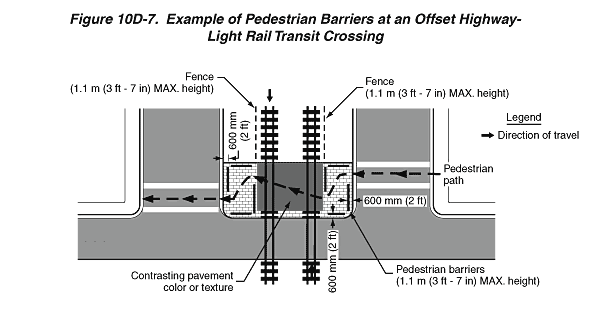|

Figure 10D-7. Example of Pedestrian Barriers at an Offset Highway-Light
Rail Transit Crossing
This figure illustrates an example of pedestrian barriers used
at an offset highway-light rail transit crossing. A legend shows
a black arrow indicating the direction of travel.
The figure shows an intersection of a horizontal roadway with two
vertical lanes of a roadway with two light rail transit tracks shown
between them. Black arrows show the direction of travel on the tracks
as top to bottom on the left track and bottom to top on the right
track. Narrow rectangular white areas are shown on the outsides
of the vertical lanes and the upper edge of the horizontal roadway
indicating sidewalks. Rectangular areas with small horizontal rectangles
indicating brick walkways are shown on both sides of the tracks.
A horizontal rectangular gray area indicating contrasting pavement
color or texture crosses the tracks at a right angle. Vertical broken
lines indicating fences on both sides of the tracks are shown extending
from the outside edges of the track crossing and running parallel
to the tracks. The fences are shown as a dimension of 1.1 m (3 ft-7
in) MAX. height. Parallel white lines indicating crosswalks are
shown marked on each vertical lane at their intersection with the
horizontal roadway. The crosswalks are shown on both sides of the
tracks but are not directly opposite each other; they are offset
by several meters or feet.
The brick walkways are shown enclosed by broken black lines indicating
sections of unconnected pedestrian barriers shown as a dimension
of 1.1 m (3 ft-7 in) MAX. height. These barriers are shown at a
dimensioned distance of 600 mm (2 ft) inside the edge of the brick
walkways. They are shown as set up so that no openings between the
barriers are opposite each other. Black arrows show that the direction
of travel of the pedestrian path is from right to left from a sidewalk
across a crosswalk, straight through an opening in the pedestrian
barrier, diagonally down and to the left across the brick walkway
and through another opening in the pedestrian barrier, diagonally
up and to the left across the tracks and through another opening
in the pedestrian barrier, diagonally down and to the left across
the brick walkway and through an opening in the pedestrian barrier,
and straight across a crosswalk to a sidewalk.
Back
to Chapter 10D
|

